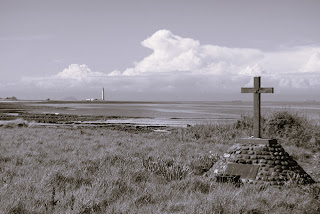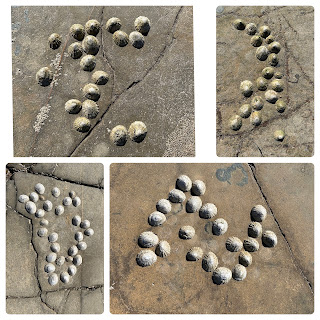Skateraw
is a small hamlet, farm, and area of land by the coast in East Lothian. It sits very close to Torness Nuclear Power
Station, which dominates the skyline of the area.
The
coastline around here is very picturesque, despite what many may see as the
carbuncle of the power station that sits over it. However, I think that it actually adds to the
area in a way. This stark industrial
building of blue grey melds into the changing light of the sky and almost
compliments the more organic remains of the stone buildings of old industry
that sit here. For this is an area with
an industrial past.
Skateraw
is in an area rich with limestone deposits, and this was quarried and burnt to
produce lime. Lime was used in the
manufacture of mortar and as an agricultural fertiliser. In the Eighteenth Century a lime kiln was
built on the shore of Skateraw, and the kilns produced lime on such a massive
scale that a harbour was built so that it could be easily exported by ship to
other areas of the country. The harbour
was destroyed by the sea in the late Nineteenth Century, though the remains of
it can still be seen at low tide.
The
destructive powers of the sea are something that have haunted this area over
the centuries, from washing away buildings on the shore, to wrecking and
sinking ships that were passing by.
On
a piece of land projecting out of the shore, there used to stand a small chapel
that was dedicated to St. Dennis. It is
rumoured that the chapel was often used to store the bodies of those washed up
from the numerous ships that were wrecked on the offshore rocks. There, they would lay to either be claimed by
their relatives, or to be buried in the nearby fields. It
appears that the chapel eventually fell into disrepair and the ruins of it were
washed away and reclaimed by the sea, disappearing forever under the waves sometime
in the 1830s. Bones were later recovered
in vicinity near to where the chapel had stood, leading to the belief that it
must have been the burial ground for the chapel.
There
are many stories of the ships that were wrecked on the rocks by Skateraw. One of the most remarkable was that of two
frigates, the Nymph, and the Pallas. On
the night of the 18th of December 1810, these two ships were
returning from a patrol of the North Sea when they mistook the lights burning
from some of the limekilns for those of the Isle of May, and those on the Isle
of May for the Bell Rock. Changing course,
they both struck the rocks at Skateraw.
The Nymph ended up right by the shore and tipped so that its masts
almost touched the limekilns there. This
was a spot of luck for the sailors on board, as they all managed to scramble
over the masts and get safely to land.
In the dark of the night no one could see what had happened to the other
ship, the Pallas, and it was feared it had sunk. Then at daylight it was found that it was
stuck on the rocks with many of the sailors clinging to the wreck for dear
life. Boats were launched and most of
the men were rescued and brought to shore, where they were provided with
shelter and blankets to warm them.
Unfortunately,
most were not as lucky, and there are various accounts of the shore being
scattered with bodies and wreckage from ships that had floundered on the rocks.
Unlike
many places in Scotland, Skateraw does not appear to have any connection with
Mary, Queen of Scots, or to have been visited by her. However, there was one rather famous visitor
who stayed in the farmhouse there, that being Scotland’s national bard, Robert
Burns. On a visit to Dunbar in 1787, he made
the acquaintance of a Mr Lee, who owned the farm at Skateraw, and was invited
to dine and also to spend the night there.
Burns described Mr Lee as ‘a farmer of great note…an excellent,
hospitable, social fellow, rather oldish; warm-hearted and chatty – a most
judicious, sensible farmer.’ Indeed, Burns must have taken to the old fellow,
as in the morning, before he left, he took a volume of his poetry, owned by
Lee, and especially for him, filled in the blank names of those he had
mentioned in his poems. This book was
then kept in the Lee family for many years, before being sold for the princely
sum of £50 at Sotheby’s, around 1892.
During
the First World War there was an airfield as Skateraw. Well, I say airfield, it was actually what
was called a landing site and was really there to be used in emergencies, such
as, if the planes couldn’t get back to their permanent base because of bad
weather or engine failure. It was used
by the No. 77 Home Defence Squadron, and when they were out flying, the farmer
who owned the land would be telephoned and asked to make sure that there was no
livestock wandering on the landing strip.
During
the 1930s, the minister of the Canongate church in Edinburgh, Reverend Ronald
Selby Wright, set up the Canongate Boys Club for the poor boys living in the
parish. He frequently took them camping at Skateraw where they built a hut at
Chapel Point. Near to where the hut used
to stand, there is now a memorial cross to six of the boys who were killed in the
Second World War.
While
out on my walk around Skateraw I clambered over some of the rocks that were
exposed during the low tide. On them
were lots of limpets that had created patterns that almost looked like the
symbols of some strange and alien language.
I
then headed round to the remains of an old cottage. The cottage, rather than becoming a ruin due
to abandonment and decay, was demolished in 1981, during the construction of
the nuclear power station. This was so
that those protesting against the power station couldn’t occupy it. Bit of a waste of a cottage if you ask me,
but no one did.
In
the warm and lovely afternoon sunshine of my wander around Skateraw, I left the
Skulferatu that had accompanied me in the wall of the ruined cottage.
The
coordinates for the location of the Skulferatu are –
Latitude
55.973844
Longitude
-2.421947
what3words:
harshest.cherub.retract
I
used the following sources for information on Skateraw –
The New Statistical Account of Scotland
Vol II, Linlithgow-Haddington-Berwick
By the Ministers of Respective Parishes, etc.
1845
The History of Dunbar
By James Miller
1859
The complete works of Robert Burns
by Robert Burns & Alexander Smith,
Alexander
1887
The Athenaeum Journal of Literature, Science,
The Fine Arts, Music and the Drama
January to June 1887
Canmore
Scram, No 24 – June/July 1991
Our Club
By Ronald Selby Wright
1969




























.jpg)






